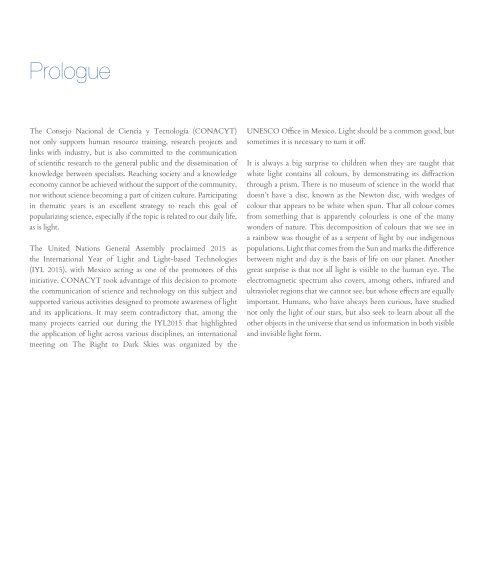A LOS CIELOS OSCUROS
2n1XdqD
2n1XdqD
You also want an ePaper? Increase the reach of your titles
YUMPU automatically turns print PDFs into web optimized ePapers that Google loves.
Prologue<br />
The Consejo Nacional de Ciencia y Tecnología (CONACYT)<br />
not only supports human resource training, research projects and<br />
links with industry, but is also committed to the communication<br />
of scientific research to the general public and the dissemination of<br />
knowledge between specialists. Reaching society and a knowledge<br />
economy cannot be achieved without the support of the community,<br />
nor without science becoming a part of citizen culture. Participating<br />
in thematic years is an excellent strategy to reach this goal of<br />
popularizing science, especially if the topic is related to our daily life,<br />
as is light.<br />
The United Nations General Assembly proclaimed 2015 as<br />
the International Year of Light and Light-based Technologies<br />
(IYL 2015), with Mexico acting as one of the promoters of this<br />
initiative. CONACYT took advantage of this decision to promote<br />
the communication of science and technology on this subject and<br />
supported various activities designed to promote awareness of light<br />
and its applications. It may seem contradictory that, among the<br />
many projects carried out during the IYL2015 that highlighted<br />
the application of light across various disciplines, an international<br />
meeting on The Right to Dark Skies was organized by the<br />
UNESCO Office in Mexico. Light should be a common good, but<br />
sometimes it is necessary to turn it off.<br />
It is always a big surprise to children when they are taught that<br />
white light contains all colours, by demonstrating its diffraction<br />
through a prism. There is no museum of science in the world that<br />
doesn’t have a disc, known as the Newton disc, with wedges of<br />
colour that appears to be white when spun. That all colour comes<br />
from something that is apparently colourless is one of the many<br />
wonders of nature. This decomposition of colours that we see in<br />
a rainbow was thought of as a serpent of light by our indigenous<br />
populations. Light that comes from the Sun and marks the difference<br />
between night and day is the basis of life on our planet. Another<br />
great surprise is that not all light is visible to the human eye. The<br />
electromagnetic spectrum also covers, among others, infrared and<br />
ultraviolet regions that we cannot see, but whose effects are equally<br />
important. Humans, who have always been curious, have studied<br />
not only the light of our stars, but also seek to learn about all the<br />
other objects in the universe that send us information in both visible<br />
and invisible light form.


